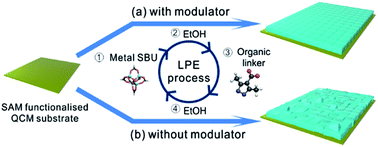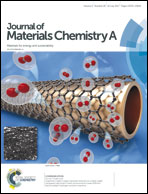Enhanced properties of metal–organic framework thin films fabricated via a coordination modulation-controlled layer-by-layer process†
Abstract
One of the primary challenges facing the integration of metal–organic frameworks (MOFs) with real-world technologies is the development of enhanced fabrication processes that maximize compatibility with specific device configurations, while maintaining or even improving the performance profile relative to bulk MOF materials. Stepwise liquid-phase epitaxy (LPE) has emerged as an important method for depositing MOF thin films on a variety of substrate types, although current limitations include challenges in obtaining well-oriented and highly crystalline thin films, and the applicability of the technique beyond the most common MOF structure types (e.g. paddlewheel-based MOFs). Coordination modulation is a method often employed for controlling MOF crystal growth processes within bulk crystallization solutions and presents a potentially powerful route for manipulation of the properties of MOF thin films via integration into a LPE-based process. In this work, coordination modulation is employed in the LPE fabrication of thin films composed of the Zn4O(L)3 structure type (L2− = 3,5-dialkyl-4-carboxypyrazolate). The films are grown on Au-coated quartz crystal microbalance (QCM) substrates, allowing both film deposition and molecular adsorption to be precisely probed. Addition of a modulator during the LPE process leads to enhanced orientation and crystallinity that offers a boost to the adsorption capacities of polar adsorbates when using a small molar ratio of the modulator. Closer inspection of the QCM data reflects a change in growth kinetics, which influences the quantity of MOF deposited per growth cycle and the overall growth rate. In all, this integrated fabrication process could provide a potentially versatile route for the fabrication of a wide range of MOF thin films with enhanced characteristics.



 Please wait while we load your content...
Please wait while we load your content...